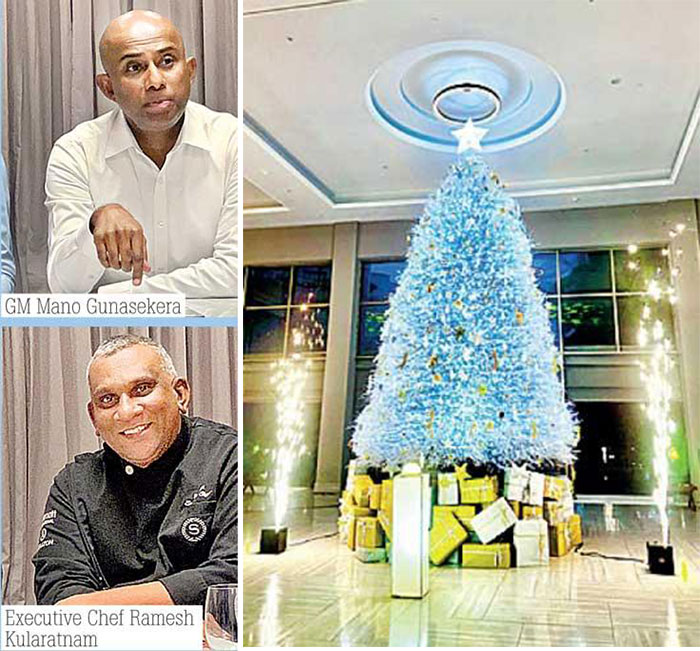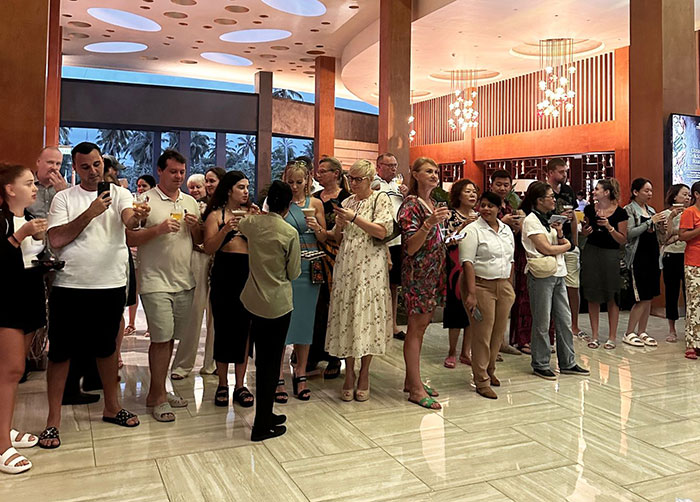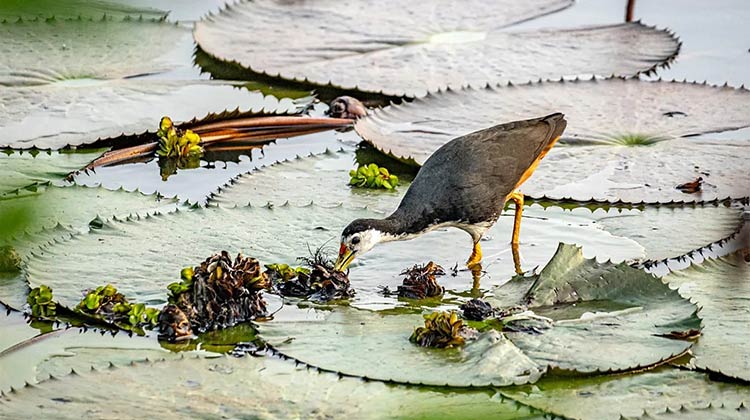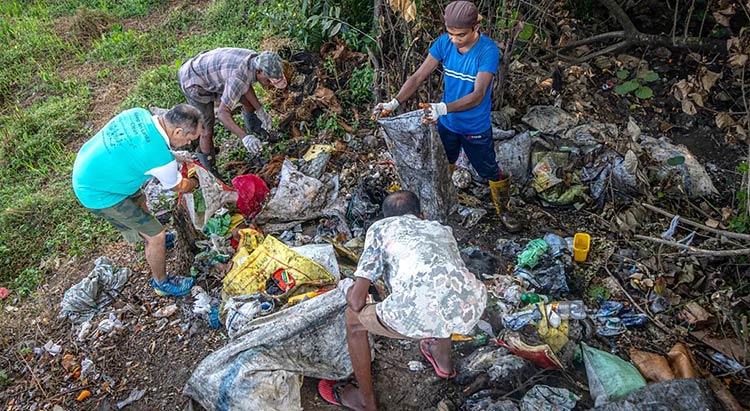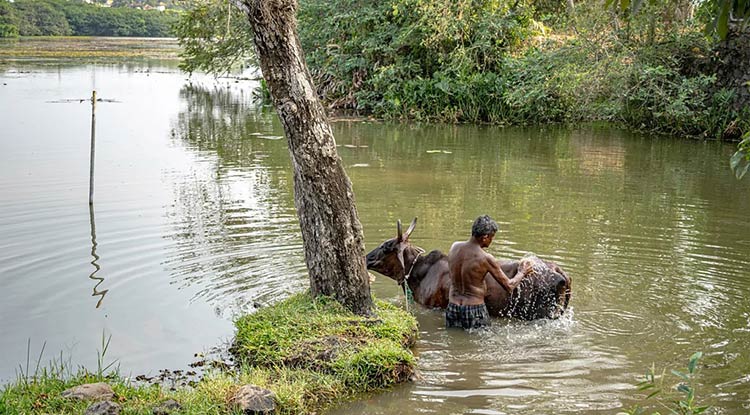Life style
Spirit of seasonal cheer at Kosgoda

 Immerse in the enchanting holiday spirit at Sheraton Kosgoda sharing moments of togetherness with cherished ones, indulge in delightful festive creations that promise to etch lasting memories.
Immerse in the enchanting holiday spirit at Sheraton Kosgoda sharing moments of togetherness with cherished ones, indulge in delightful festive creations that promise to etch lasting memories.
The Hotel Sheraton Kosgoda heralded the festivities with their annual Christmas tree lighting ceremony in the company of guests, staff members and media personnel. It was a magical moment, spreading the holiday cheer and bringing in the spirit of Xmas.
The Xmas carols sung by the popular Choro Calibre choir added a cheerful atmosphere to the evening soiree bringing joy to all those present.The evening progressed to cheerful chatter with the gathering of guests and patrons being hosted to snacks and drinks.
Speaking on the occasion the newly appointed General Manager Mano Gunasekera stated that there have a line up of festive packages and options for accommodation, dining and gifts to keep the guests on top of thier holiday checklist.
The mesmerising Christmas tree was adorned with sparkling lights and colourful décor, creating the true feeling of Xmas and the surprise visit of the majestic Santa with many gifts to the children was the highlight of the evening celebrations.
Mariott Kosgoda Hotel located just 90 k.m. from Colombo in the idyllic coastal town of Kosgoda offers a perfect escape from the hustle and bustle of city life. The lush greenery and the breathtaking pristine beaches , add to the beauty of the hotel. During this time of the year, the
Christmas decorations adorned the hotel enhancing the festive ambience.Accommodations offer the perfect blend of luxury adding an aura of comfort to the weary traveller.
The culinary experience curated by executive chef Ramesh Kularatnam, with many years of experience add value to the guests. Whether indulging in the rich flavours of Sri Lankan cuisine or the variety of delectable international cuisine add a gastronomical journey.
Seafood diners will relish a hearty array of ocean treasures, complemented by appetisers, mouthwatering menus and lip smacking desserts.
bands of with performances from bands of music
Christmas Eve, Christmas Day and New Year’s Eve celebrations will be the attraction with leading entertainers and performances.December 24th Christmas Eve dining sessions have now been finalised at ‘S Kitchen’, at ‘The Olive Restaurant’ and at Beachside Garden, while Christmas Day buffet will be a grand feast at the main restaurant.
The popular band ‘Omega’ will be in action at the Grand Ballroom at the New Year’s Eve Dinner Dance with unlimited beverages on offer, while BBQ dinner at the garden with fireworks will also come alive on 31st.
The General Manager said he aims to lure many tourists for the year 2024.He analysed the business potential of Kosgoda Sheraton as an emerging destination for luxury travellers and destination weddings.
He said “My intention is to transform dreams into reality and craft unique narratives that resonate with every traveller’s heart.To the question what will the future of the hospitality industry in Sri Lanka he said “we are excited to elevate guest experiences, creating new experiences every time on a journey towards becoming a global hospitality leader while staying true to our Sri Lankan roots.”
Life style
The fight to save Sri Lanka’s natural flood buffers

By Zinara Rathnayake
Pay Drechsel is going for his daily morning walk around Talangama Wetland, in Sri Lanka’s capital Colombo. The sun casts a warm glow over flowering pink water lilies as a farmer scrubs down his water buffalo. A kingfisher hovers nearby. Soon, photographers will arrive to capture curved-necked egrets, waders probing for crawling worms, and little cormorants diving for freshwater fish.
Talangama Wetland and its surrounding swamps, reedbeds, canals and rice fields teem with life. But this hasn’t always been the case. About 15 years ago, these ecosystems were degraded and filled with rubbish. They were “dirty, very dirty”, says Drechsel, interim country manager at the International Water Management Institute (IWMI) in Colombo.
He recalls how he spent one Christmas almost a decade ago cleaning the lake, scouring for piles of rotting garbage leaking contaminants into the water, and sorting waste for recycling. To his surprise, passersby stopped and started helping him. “I realized it’s not only me, locals also appreciate it,” he says. “But like me over all the years, they may have been waiting for someone to take the lead.”
The community came together to keep the massive wetland complex clean, forming the Talangama Wetland Watch. Residents organize weekly collection runs, piling up sorted waste at a small collection unit which the municipality sends off for recycling. School kids volunteer, kayaking through the lake to dig up invasive water hyacinth.
Home to over two million residents, Colombo is built on and around a massive network of wetlands. In 2018, Colombo became one of the 18 Ramsar wetland cities in the world – an accreditation which recognizes cities for their commitment to restore, safeguard and value wetlands, with 25 new cities added to the list in 2022.
As Colombo is located in a river basin, the city is naturally prone to floods. Colombo’s wetlands act as a flood buffer, with 40% of floodwaters draining into wetland areas. They also sink carbon, purify the air and control temperatures. As temperatures warm and rains become more erratic, “wetlands are important to the city to mitigate climate change impacts”, says Chethika Gunasiri, an environmental scientist at the University of Tokyo who was part of Colombo’s Ramsar application. “Wetlands help Colombo mitigate pollution and natural disasters. They help reduce human stress as more and more people are now living in high rise buildings,” she adds.
Historically, wetlands were a “part and parcel of people’s lives in Colombo,” says Missaka Hettiarachchi, a senior fellow at the World Wildlife Fund’s environment and disaster management programme, who has been studying wetlands in Colombo for several years. Ancient kingdoms thrived in a well-managed wetland system where people used them for transport and to grow food, Hettiarachchi says.
Their downturn began in the British colonial period from the late 18th Century. When industries grew, people acquired wetlands to drain for building housing and businesses. A flood retention scheme introduced during British rule in 1924 led to the creation of man made drainage canals, preventing people from travelling through the wetlands. Although they are regularly cleaned, many of these canals are now polluted and choked with invasive plants.
- The restoration has boosted wildlife populations in Colombo’s wetlands
- Thalangama Wetland in Colombo used to be filled with rubbish but is now teeming with life
“The canals are no longer enough to prevent Colombo from flooding,” says Gunasiri.
After independence in 1948, subsequent governments declared some wetlands for flood buffering, and filled up others to make space for living, Hettiarachchi says. “And people thought wetlands were also a very, very attractive space for garbage dumps, because, you know, no one is living there, right?” This meant that people dumped everything from food waste to solid waste and chemicals while releasing sewage into the wetlands.
From the 1980s, massive rubbish mountains began to appear in natural wetlands, such as Meethotamulla in the Colombo metropolitan area, which spans 100,000 sq m (107,639 sq ft) and stands 60m (197 ft) tall. The wetland was closed after one of the rubbish mountains collapsed and killed 32 people in 2017.
During the civil war (1983-2009), the encroachment of wetlands continued, as they were sold to internally displaced people, Hettiarachchi says. Some marshy wetlands turned into shrub habitats that couldn’t hold enough water to protect the city from flooding, he says. According to one study, Kolonnawa Marsh, which forms the largest part of Colombo’s flood retention belt, has lost 65% of its area since the 1800s. A 2014 study concluded that 44% of the marsh has turned into a shrubland. The soil too has changed, reducing its capacity to absorb and drain water, leading to increased flooding and disasters.
By the 2000s, the city’s wetlands were “a bloody mess”, Hettiarachchi says. During his PhD, he would ask residents living near the degraded wetlands about these ecosystems, and they would respond: “No, we don’t know any wetlands.”
The decline of the wetlands made Colombo more prone to flooding. In 2010, a series of disastrous floods affected nearly 700,000 people and submerged the country’s parliament. This led to a shift in government policy. “I think it took a few significant flooding events for the government to realize, okay, wetlands are a significant flood control mechanism, so we need to do something about it,” says Radheeka Jirasinha, a freshwater and wetland management researcher at IWMI.
As part of the ongoing revival, the government introduced the metro Colombo wetland management strategy in 2016, which aims to include wetlands in urban planning, prevent further wetland loss, restore the ecosystems and involve the local community in their conservation. Following that, wetlands were incorporated into urban infrastructure by constructing cycling tracks, jogging paths and recreational areas around them.
“The idea was to bring people to the wetlands,” Gunasiri says. The government initiatives pulled up invasive species like water hyacinth and introduced new soil and wetland plants to attract birds and other animals.
Today, Colombo is home to four wetland parks and several other recreational spaces linked by wetlands. These restored wetlands look very different from those left untended. Photographer Nazly Ahmed says that when he went to Kotte, a Colombo suburb and the administrative hub of the country, in the late 1990s to play cricket with friends, the wetlands were covered entirely by water hyacinth. This invasive weed clogs waterways, grows over native plants, reduces oxygen and creates breeding grounds for mosquitoes, and their growth is linked to poor water quality and high pollution levels.
This Colombo suburb is now home to jogging paths and bird watching spots built around the wetlands and waterways. “No one knew about wetlands then, but people are talking about wetlands now,” says Ahmed.
Gunasiri says these green infrastructure projects have helped people to engage with the city’s wetlands again and that people now flock to the urban wetland parks for an evening jog. “When these natural systems become public areas, people start to have a sense of ownership,” she says.
Jirasinha agrees. People feel that they can use these spaces now, she says. “They’re concerned about what is happening. And suddenly, people look at the water and are like, ‘Hey, it’s polluted…where is that coming from’?”
It’s not only the government that is managing Colombo’s wetlands. Community initiatives like the Talangama Wetland Watch have started to take responsibility too. “If you keep wetlands free from rubbish and maintain them, they increase the property value in urban areas,” says Drechsel, who believes people are willing to pay twice as much for land with wetland views.
Although there’s an attitude shift and residents are now aware of the value the wetlands add to the city, problems are far from over, Hettiarachchi says. After the civil war ended in 2009, Colombo’s urban population expanded rapidly. Developments sprung up, leading to the draining of wetlands for housing, businesses and infrastructure. Since 2009, Colombo has lost 2.12 sq km (0.8 sq miles) of its wetlands.
According to a 2024 study, wetlands absorb 62.1mm more floodwater than built up areas in Colombo. Despite collective efforts to clean and restore some of the city’s wetlands, the overall loss of wetland area means that Colombo is becoming more vulnerable to floods, the 2024 study notes.
The Ramsar accreditation pushed the state government to temporarily suspend filling and destroying any wetlands. “So there’s definitely proactive action to safeguard the city’s wetlands, but we need a coordinated effort from government, non-profits and communities to stop their degradation,” says Chaturangi Wickramaratne, a freshwater ecologist at IWMI.
Gunasiri explains that wetland education is vital for citizens to understand their importance in urban resilience. “More and more wetlands need to be a part of the city’s functions, linked to people’s well-being, so people begin to care about them more,” she says.
Wetlands can also help with the city’s food shortages, says Hettiarachchi. “You don’t need irrigation systems to grow food, you can use these ecosystems – they are also fabulous breeding grounds for fish,” he says.
Behind the new use of Colombo’s wetlands for people’s well-being, Gunasiri notes an underlying urgency to protect these ecosystems. “If we lose our wetlands, Colombo will be unliveable.
“BBC”
Life style
Hilton Sri Lanka Triumphs with 12 of the 25 Awards Won by Hotels and Resorts Across the Country

Hilton Sri Lanka has once again demonstrated its leadership hospitality, taking home an impressive 12 awards across four properties at the prestigious World Luxury Hotel Awards gala held in Bali, Indonesia. The accolades serve as a testament to the brand’s commitment to excellence, world-class service, and innovative guest experiences said a release.
Among the standout winners, Hilton Colombo was honored as a Luxury Business Hotel (Regional), Luxury Conference and Event Hotel (Country), and also secured recognition for Best Architectural Design (Regional). With a 37-year legacy, Hilton Colombo continues to set the bar for luxury hospitality in the heart of Sri Lanka.
Hilton Colombo Residences, located just minutes away from the flagship hotel, also added to the accolades with titles such as Luxury Family Hotel (Regional), Luxury Residences (Regional), and Luxury City Hotel (Country). The property is renowned for providing comfort and sophistication, particularly for families and long-stay travelers.
In southern Sri Lanka, DoubleTree by Hilton Weerawila Rajawarna Resort earned global recognition as the Best Lakeside Resort, alongside Best Presidential Suite (Continent) and Luxury Family Resort (Regional).
Adding to the success, Hilton Yala Resort, the latest addition to Hilton Sri Lanka’s portfolio, was acknowledged for Best Interior Design (Global) and secured wins in the categories of Luxury New Resort (Continent) and Luxury Wildlife Resort (Continent).
Commenting on the achievement, Manesh Fernando, Area General Manager for Hilton Sri Lanka and General Manager of Hilton Colombo, said: “We are incredibly proud of these awards, which underscore our unwavering dedication to delivering unparalleled guest experiences. his recognition would not have been possible without the continued support of our valuable guests, owners, team members, and community, and we extend our heartfelt thanks to everyone who voted for us. Your trust and loyalty inspire us to strive for excellence continually.”
The World Luxury Hotel Awards is one of the most coveted accolades in the global luxury hospitality industry, recognizing exceptional service and innovation across a variety of categories.
Life style
The Grand Kandyan Christmas cake mixing with the cricket stars

The Grand Kandyan Hotel was alive with seasonal cheer as it hosted its annual Christmas cake mixing event, bringing together fans, families, and cricket stars for a joyous celebration.
Cricket stars joined the festivities, adding a special touch to the occasion. Their presence not only drew crowds but also fostered a great sense of community spirit, as fans interacted with their heroes while preparing for the upcoming holiday season. The air was filled with the delightful aromas of fruits, nuts, and spices, evoking the warmth and joy of Christmas.
-

 Business6 days ago
Business6 days agoStandard Chartered appoints Harini Jayaweera as Chief Compliance Officer
-

 News7 days ago
News7 days agoWickremesinghe defends former presidents’ privileges
-

 Opinion7 days ago
Opinion7 days agoDevolution and Comrade Anura
-

 News5 days ago
News5 days agoFifteen heads of Sri Lanka missions overseas urgently recalled
-

 News5 days ago
News5 days agoFive-star hotels stop serving pork products
-
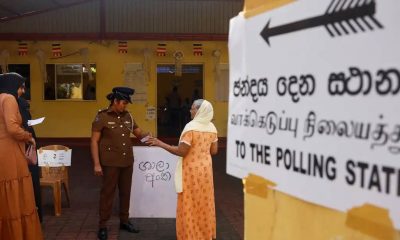
 Features5 days ago
Features5 days agoWaiting for a Democratic Opposition
-

 News4 days ago
News4 days agoITAK denies secret pact with NPP
-

 Sports7 days ago
Sports7 days agoChamika, Anuka shine as Mahanama beat Nalanda

